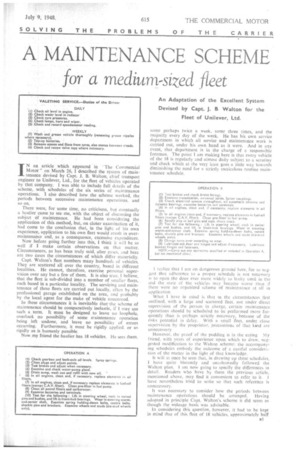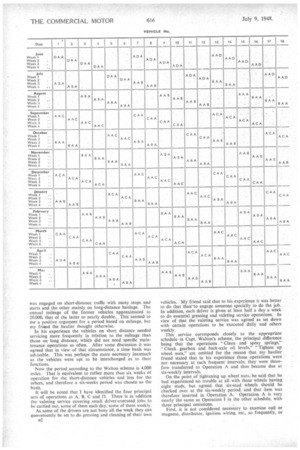A MAINTENANCE SCHEME
Page 35

Page 36

Page 37

If you've noticed an error in this article please click here to report it so we can fix it.
for a medium-sited fleet
An Adaptation of the Excellent System Devised by Capt. J. B Walton for the Fleet of Unilever, Ltd.
IN an article which appeared in The Commercial Motor" on March 26, I described the system of maintenance devised by Capt. J. B. Walton, chief transport engineer to Unilever, Ltd., for the fleet of vehicles operated by that company. I was able to include full details of the scheme, with schedules of the six series of maintenance operations. I also described how the scheme worked, the periods between successive maintenance operations, and so on.
There were, for some time, no criticisms, but eventually a haulier, came to see me, with the object of discussing the subject of maintenance. He had been considering the application of this method, but, on closer examination of it, had come to the conclusion that, in the light of his own experience, application to his own fleet would result in overmaintenance and, as a consequence, excessive expenditure. Now before going further into this, I think it will be as well if I • make certain observations on that matter. Circumstances, as has been truly said, alter cases, and here are two oases the circumstances of which differ materially. Capt. Walton's fleet numbers many hundreds of vehicles. They are scattered all over the country, based in different localities. He cannot, therefore, exercise personal supervision over any but a few of them. It is also true, I believe, that the fleet is sub-divided into a number of smaller fleets,, each based in a particular locality. The servicing and maintenance of these fleets are carried out locally, often by the professional garage established on the area, and probably by the local agent for the make of vehicle concerned.
In these circumstances it is inevitable that the scheme of maintenance should be comparatively inelastic, if I may use such a term. It must be designed to leave no loophole, overlook no possibility of some maintenance operation being left undone, and leave no possibility of errors occurring. Furthermore, it must be rigidly applied. or as rigidly as is humanly possible
Now, my friend the haulier has 18 vehicles. He sees them.
some perhaps twice a week, some three times, and the majority every day of the week. He has his own service department in which all service and maintenance work is carried out, under his own hand as it were. And in any event, that department is in the charge of a responsible foreman. The point I am making here is that every vehicle of the 18 is regularly and almost daily subject to a scrutiny and check which at the very least goes a little way towards diminishing the need for a strictly meticulous routine maintenance schedule.
I realize that I am on dangerous ground here, for to suggest that adherence to a proper schedule is not necessary is to open the door ever more widely to laxity until in the end the state of the vehicles may become worse than if there were no organized scheme of maintenance at all in application.
What I have in mind is that in the circumstances first outlined, with a large and scattered fleet, not under direct supervision of the person in charge, certain maintenance operations should be scheduled to be performed more frequently than is perhaps strictly necessary, because of the risks potential in delay. With a small fleet, under close supervision by the proprietor, precautions of that kind are unnecessary However, the proof of the pudding is in the eating. My friend. with years of experience upon which to draw, suggested modification to the Walton scheme: the accompany ing schedules embody the outcome of a careful consideration of the matter in the light of that knowledge.
IL will at once be seen that, in drawing up these schedules, I have quite blatantly and unashamedly followed the Walton plan. I am now going to specify the differences in detail. Readers who have by them the previous article, mentioned above, may find it convenient to refer to it. t have nevertheless tried to write so that such reference is unnecessary, it was necessary to consider how the periods between maintenance operations should be arranged. Having adopted in principle Capt. Walton's scheme it did seem as though the mileage basis was advisable.
In considering this question, however, it had to be kept in mind that of this fleet of 18 vehicles, approximately half was engaged on short-distance traffic with many stops and starts and the other mainly on long-distance haulage. The annual mileage of the former vehicles approximated to 20.000, that of the latter to nearly double. This seemed to me a positive argument for a period based on mileage, but my friend the haulier thought otherwise.
In his experience the vehicles on short distance needed servicing more frequently in relation to the mileage than those on long distance, which did not need specific maintenance operations so often. After some discussion.it was agreed that in view of that circumstance, a time basis was advisable. This was perhaps the more necessary inasmuch as the vehicles were apt to be interchanged as to their functions.
Now the period according to the Walton scheme is 4,000 miles. That is equivalent to rather more than six weeks of operation for the short-distance vehicles and less for the others, and therefore a six-weeks period was chosen as the basis.
It will be noted that I have identified the four principal sets of operations as A. B. C and D. There is in addition the valeting service covering small driver-executed jobs to be carried out, some of them each day, some of them weekly.
As some of the drivers are not busy all the week they can conveniently be set to do greasing and cleaning of their own a2
vehicles. My friend said that in his experience it was better to do that than-to engage someone specially to do the job. In addition, each driver is given at least half a day a week to do essential greasing and valeting service operations. In view of that the valeting service was agreed as set down with certain operations to be executed daily and others weekly.
This service corresponds closely to the appropriate schedule in Capt. Walton's scheme, the principal difference being that the operations "Clean and spray springs," "Check gearbox and back-axle oil levels," ." Tighten up wheel nuts," are omitted for the reason that my haulier friend stated that in his experience those operations were not necessary at such frequent intervals; they were therefore transferred to Operation A and thus became due at six-weekly intervals.
On the point of tightening up wheel nuts, he said that he had experienced no trouble at all with those wheels having eight studs, but agreed that six-stud wheels should be checked over at the six-weekly period, and that item was therefore inserted in Operation A. Operation A is very nearly the same as Operation I in the other schedule, with three principal omissions. First, it is not considered necessary to examine coil or magneto, distributor, ignition wiring, etc., so frequently, or to adjust the tappets. In particular, my friend said that in his view it was not necessary to "Remove clutch cover plate; sparingly lubricate clutch-pedal lever and adjust pedal travel if necessary." He had not found that there was need for that to be done every six weeks.
Coming now to Operation B, which occurs every third period, that is to say every The weeks or approximately from 9,000 to 16,000 miles, the Walton schedule No. 2 was copied, except as regards decarbonizing and associated operations, the measuring and recording of cylinder-bore wear, the removal of hubs, examination for wear and the making of necessary adjustments or to check wear in differential: Here again my friend said that in his experience it was not necessary to perform those operations so frequently.
In Operation C this decarbonizing and a comprehensive series of associated operations are included and, generally speaking, Schedule C corresponds closely with Schedule 3 in the previous article.
The fourth, Schedule D, is, of course, chassis and body overhaul throughout.
In discussing these schedules 1 discovered a need for making a plan of operations such as that set down in the accompanying ditotratn. That arose because my friend stated that in his experience a general overhaul of either type of vehicle was unnecessary in any period under three years and he stipulated that any maintenance schedules should be based on that period. Moreover, these major overhauls must be arranged to be carried out in June and the beginning of July, That meant that for each vehicle a schedule of operations had to be drawn up to cover a period of three years commencing, or ending, with the major overhaul to take place in June.
As this article and scheme could not be prepared in time for the beginning of June this year I framed it on the understanding that some of the vehicles would be undergoing that overhaul while the scheme was in preparation and that I could start from that as a basis. There being 18 vehicles, it is clear that six must be overhauled each year and that is how t have arranged it.
In the table it will be seen that the vehicles are numbered 1 to 18. .
Vehicles No. I to 6 are overhauled in the six weeks from the first week in June to the first week in July inclusive. That is the meaning of the letter 1.1 under each vehicle at the appropriate dates. In the next year the vehicles No. 7 to 12 arc similarly treated and in the third year vehicles No. 13 to 18 inclusive.
It will be noted that in each column headed by the vehicle number there are three sub-columns and that provides for a complete series of operations in respect of that vehicle, covering a period of three years. Vehicle No. I. for example, it wilL be noted, starts with Operation D in the first week in June e that is its major overhaul. At intervals of approximately six weeks come Operation A, which is carried out twice, then at the third period Operation B, then follows A twice and then Operation C, and 50 on, two more Operations A. then B. Iwo Operations A-and then C until the three years are up.
A 48-week Year It will' be noticed that I have allowed for only four weeks in each month, 48 weeks in the year. That means, of course, that four times during the year seven weeks will elapse between the one operation and the next. I have taken the view that the extra time thus involved is of less consequence than that of being able to provide a plan such as that-shown which can be followed easily and without the need for a calendar arid specified dates for each operation..
• One criticism which will probably arise is that I am putting the cart before the horse and attaching more importance to paper work and neat planning than to the spacing of the operations themselves. My answer to that is that to ensure success, a timetable must be of a nature In he followed simply and easily, providing no excuse for oversight, and this scheme which I have planned has that .advantage. I might point out that if the period be already admitted to be so elastic that it .plies equally to vehicles covering 20,000 miles per annum or twice that distance, then the slight additional waite of one week occasionally before the operation is carried out, is hardly likely to be
detrimental. S.T.R.




















































































